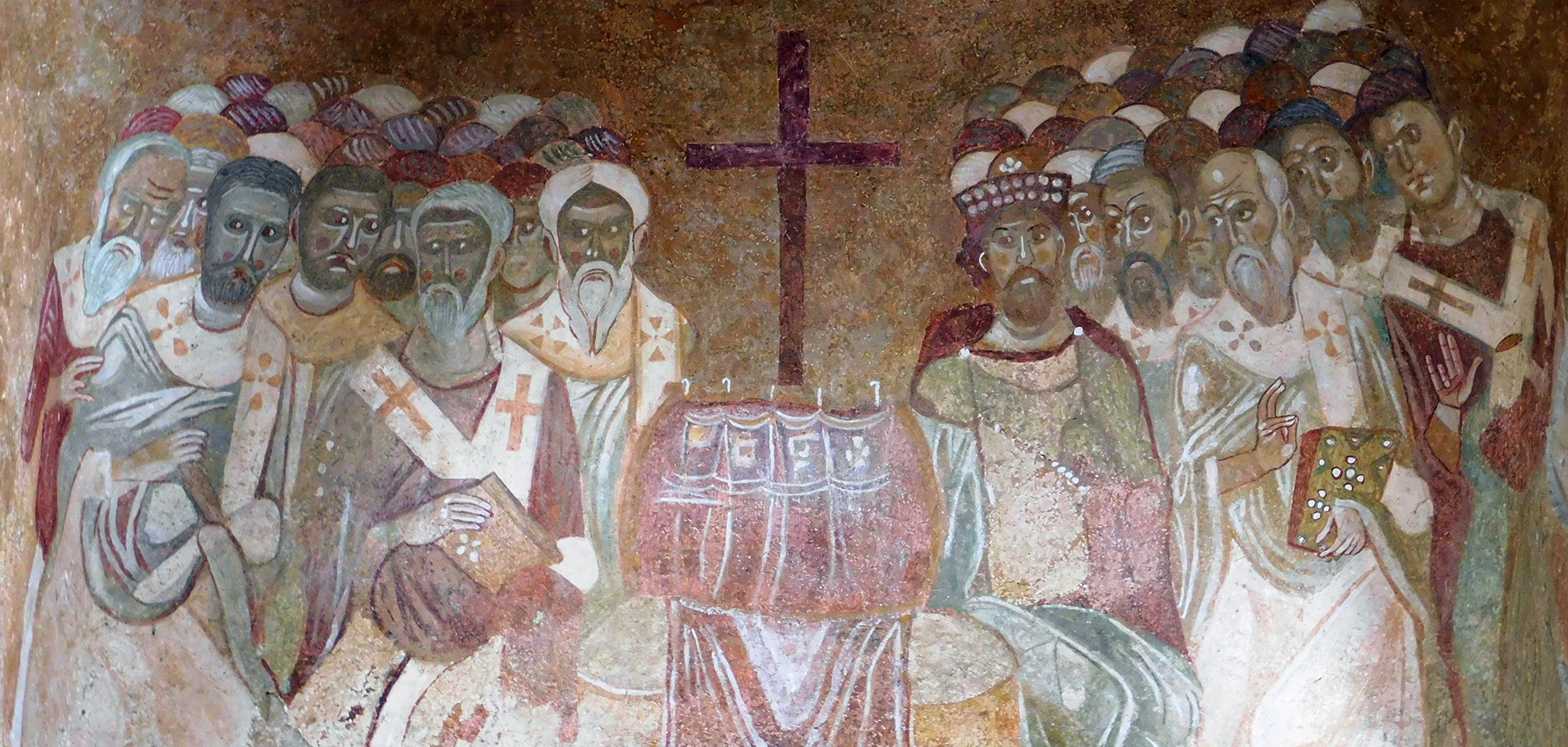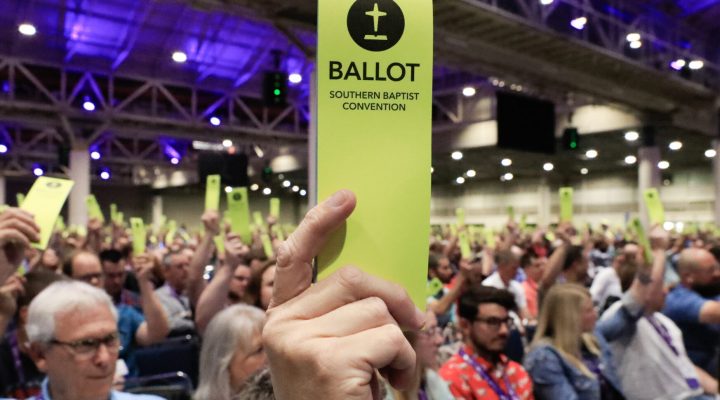The Southern Baptist Convention has been at war with itself for more than 40 years, with each new battle promising uniformity that never materializes for long.
This year’s SBC annual meeting, happening next week in Indianapolis, represents another major front in the ongoing battle to once and for all determine who’s in and who’s out in the nation’s largest Protestant denomination.

Daniel Vestal (right) congratulating Morris Chapman, who defeated him in the race for SBC president in 1990. (Southern Baptist Historical Library and Archives)
At the forefront is yet another skirmish over the role of women not only in the church but in the created order. Having driven out so-called “moderates” in the “conservative resurgence” of the late 20th century, those remaining in the SBC have continued to splinter, with women in ministry — an issue largely settled in the 1990s — serving as a proxy for bigger theological and political issues.
According to some critics, the current effort to put women in their place is a smokescreen to distract attention from the denomination’s unwillingness to address charges of mishandled sexual abuse cases, declining membership, plummeting baptism rates and insufficient church planting.
Others see this as a battle between resurgent neo-Calvinists and non-Calvinists. When the conservative resurgence began in 1979, Calvinists were few and far between in the SBC. This group of predestinarians was so scarce as to be a fringe movement. No one gave them notice.
But as conservatives swept control of the seminaries and mission boards, some of these fringe Calvinists came along for the ride and became influencers in the new SBC. At first, traditional conservative leaders — who embraced a revivalistic evangelism mentality — expressed concern about the influence of Calvinists who believe God has preordained some people to damnation and others to salvation.
There was a not-so-friendly rivalry between Al Mohler, the Calvinist president of Southern Baptist Theological Seminary in Kentucky, and Paige Patterson, president of Southeastern Baptist Theological Seminary in North Carolina and then Southwestern Baptist Theological Seminary in Texas. Patterson, a co-architect of the conservative resurgence, represented an extreme version of 20th-century revivalism.
Despite Patterson’s stature as a denominational warrior, Mohler beat him in the long game. Mohler took the SBC’s mother seminary, turned it into a Calvinist indoctrination camp and began sending out graduates and staff members to lead other SBC entities. Today, Calvinist leaders are spread across the SBC and are driving the denomination toward a more strict form of conservatism than ever before.
“Despite Patterson’s stature as a denominational warrior, Mohler beat him in the long game.”
That’s the background to understand what appears to be the most consequential vote to be taken at this year’s SBC annual meeting, on the Law Amendment. This is the second required vote on a constitutional amendment that would codify a ban on women being called “pastor,” being ordained or preaching.
The number of ordained women in Southern Baptist life today is small, as is the number of women preaching. But both practices have gained traction recently in some of the denomination’s largest churches where women preach and are ordained but still may not serve as senior pastors.

Rick Warren addresses messengers to the 2023 SBC annual meeting in New Orleans.
That’s what led the SBC’s largest church, Saddleback Church in Southern California, to be voted out last year.
Pragmatically, expelling your largest and best-known church, a congregation that has planted more new churches than any other in the denomination and has baptized more converts, does not make sense. But this decision was not about pragmatism; it was about purity.
That is the Calvinist influence at work: Pursuing doctrinal purity at all costs. Because God already has chosen who will be saved and who will be damned, the evangelistic mandate of Jesus’ Great Commission takes a back seat to theological conformity. It is better to have a smaller but doctrinally pure convention than to have a larger and slightly diverse convention.
In the conservative resurgence, the battle lines were about biblical inerrancy. Today, the battle lines are about a subset of inerrancy that demands complete conformity. Gone are the days of conservative SBC President Jimmy Draper, who talked about a “big tent” denomination.
The reality is most of the big name SBC presidents of the early days of the conservative resurgence could not get elected today. They would be deemed “liberal” by the very vocal, very present ultra-conservatives.
But this battle is not over. Even the new president of the SBC Executive Committee, Jeff Iorg, has weighed in against the Law Amendment. As has the Executive Committee itself.
The first reading last year was declared passed with a two-thirds majority by a show-of-ballots vote as ascertained by the presiding officer from the platform. Opponents of the amendment questioned that call. It is likely this year’s vote will be taken by ballot to ensure there is a clear vote.
And according to some well-placed insiders, the chances of the Law Amendment passing are smaller than you might think. Opposition has grown over the past year, and the issue is more divisive than ever.
This one vote will be a bellwether for the future of the SBC, but it will not be the only test.

SBC presidential candidates Clint Pressley, Jared Moore, Mike Keahbone, David Allen, Dan Spencer and Bruce Frank (BP photos)
Presidential election
For only the second time in history, there are six announced candidates for the SBC presidency. This is normally a field of two to three candidates.
No one knows which way the wind will blow on this one, but it is highly likely a second ballot will be required. Whoever is elected SBC president has limited ability to shape the denomination alone, as most of the real power is in the appointments to various leadership roles. However, for one year or perhaps two, the president becomes the public face of the SBC.
None of this year’s six candidates are truly high-profile pastors, although some are better known than others. Their own viewpoints range from conservative to extra conservative. Thus, the presidential election will shape the public face of the SBC at a time when the denomination has gotten a black eye for its strident opposition to LGBTQ Christians, its anti-women stances, its association with Donald Trump and modern Republican politics, its push for the abolition of all abortion and its failure to address sexual abuse.
Outgoing SBC President Bart Barber has sought to strike an aw-shucks farmer vibe that none of the six current candidates would be able to match.
Aside from the vote on the Law Amendment and the election of a president, the primary things to watch at the SBC annual meeting are reports, resolutions and motions.

Bart Barber on his Texas farm
Reports: Sexual abuse task force
Two years ago, expectations were high that a task force would recommend significant changes to acknowledge, respond to and prevent sexual abuse in churches. That task force and its successor have been almost non-events.
Critics have panned both task forces for making promises they can’t keep. Two years after the damning report from Guidepost Solutions, the SBC still hasn’t published a single name of a known or credibly accused abuser despite repeated promises to do so.
Next week, the Abuse Reform and Implementation Task Force will release a new curriculum to help local churches “establish or evaluate their abuse prevention and response plan” and will ask messengers to approve two recommendations.
The first recommendation is to affirm the objectives outlined in the task force report. The second is to urge the SBC Executive Committee to “complete the implementation of these objectives” by recommending a sufficient structure and allocating funds to do so.
The task force has no power to do anything itself and can only ask other SBC entities to do things they’ve already indicated they don’t want to do.
A new Abuse Response Commission has been established by some members of the task force but that nascent entity has no standing with the SBC and no funding. Some SBC agency heads have been openly disdainful of the idea and refused to fund it.
Reports: Cooperation Group
At last year’s annual meeting, President Barber was tasked by messengers with creating another task force to study cooperation in the SBC. That group will present four recommendations:
- Requiring amendments to the Baptist Faith and Message to follow the same process as amending the SBC Constitution and bylaws
- Giving messengers assembled at annual meetings sole authority in determining which churches are in good standing for participation and not delegating that work to the SBC Executive Committee.
- Requiring the Committee on Nominations to nominate as entity trustees and standing committee members only those candidates who “affirm” the SBC adopted statement of faith, which is the Baptist Faith and Message. How much a person has to “affirm” the statement is left for interpretation.
- Asking the SBC Executive Committee to evaluate the usefulness and accuracy of a public list of cooperating churches, which has been found to be out of date and inaccurate in multiple cases.
Earlier, the Cooperation Group said the current language of the SBC Constitution regarding membership is clear and does not need to be changed as some had proposed. The Constitution currently reads: “A church will only be deemed to be in friendly cooperation which has a faith and practice which closely identifies with the convention’s adopted statement of faith.”
This concern ties back to the Law Amendment, which would take the issue of women in ministry from “closely identifies” to absolutely identifies. The far-right wing of the SBC wants to require absolutely conformity on all doctrinal matters.

Ronnie Floyd was chairman of the Great Commission Resurgence Task Force in 2010, then nine years later was named president of the SBC Executive Committee, where the task force recomendations had largely been ignored. (BP photo)
Reports: Great Commission Resurgence Evaluation Task Force
Yet another task force has been reviewing the effectiveness of a plan adopted 14 years ago to advance the Great Commission of Jesus to preach, baptize and make disciples of all people everywhere.
The Great Commission Resurgence Evaluation Task Force found only two of seven adopted plans of action have been implemented.
This group’s six recommendations are:
- To stop using the category of “Great Commission Giving” as a supplement or alternative to Cooperative Program giving. The new language never was fully adopted and confused giving to the SBC’s unified budget, the group said.
- Restructure and simplify the Annual Church Profile to get more participation from churches in the annual data survey. The proposed simplification would leave six data points — on membership, attendance and giving — and two questions regarding preventing sexual abuse.
- Request the SBC North American Mission Board “conduct an annual survey of the status of churches planted, revitalized or otherwise assisted using Cooperative Program funds 10 years out from their launch, specifically to include data regarding: 1) the percentage of churches which are still in existence, and 2) the percentage of churches still connected to the SBC in Cooperative Program giving and ACP reporting. NAMB leaders have been hesitant to publish longitudinal data on church plants, which has fueled criticisms that NAMB is spending millions more dollars on church planting with worse results than ever before.
- “Strongly request” the Executive Committee to increase the Cooperative Program allocation sent to the International Mission Board to 51% as requested by messengers to the 2010 annual meeting. Currently, the IMB gets 41% of undesignated Cooperative Program receipts. Adding that six-tenths of a percent would give the IMB more than $1 million in additional funding, which in theory would be taken away from the Executive Committee, which gets less than 3% of Cooperative Program receipts.
- Ask the Council of Seminary Presidents to “direct the staff of the Historical Library and Archives … to begin the process of indexing the audio recordings of the original Great Commission Resurgence compact disc collection (titled AR 913) for publication on June 16, 2025, so that interested parties may have navigable access from the first day of public access.” The evaluation task force was denied access to those records, which have been sealed for 20 years.
- Change governing documents “to require entities, institutions, committees or commissions of the convention to report on the action they have taken on messenger-approved recommendations coming from special work groups or task forces.”

James Merritt with members of the SBC Committee on Resolutions in 2021. (Baptist Press)
Resolutions
Apart from things like the Law Amendment, few things stir up more problems and publicity for the SBC than the resolutions adopted by messengers. This longstanding practice is intended to express the will of each year’s body. Resolutions are not binding but are often quoted when convenient to reinforce a person’s desired outcome.
Although often addressing secular and political issues, SBC resolutions come wrapped in God talk. This year’s Resolutions Committee Chairwoman Kristen Ferguson told Baptist Press: “Working from the word of God as our inerrant authority and the Baptist Faith and Message as our confession, these resolutions represent what we believe to be Southern Baptist resolve on emerging and urgent topics of our day.”
The committee released previews of its 10 proposed resolutions in advance this year, a new requirement. Those 10 proposed resolutions are:
- On Integrity in SBC Leadership
- On Defending Religious Liberty
- On Just War and the Pursuit of Peace
- On Justice and Peace in the Aftermath of the October 7 Attack on Israel
- On the Pro-Life Ethic in a Post-Roe Society
- On the Ethical Realities of Reproductive Technologies and the Dignity of the Human Embryo
- On the God-Given Rights and Responsibilities of Parents
- On the Danger of Abusing Non-Disclosure and Non-Disparagement Agreements
- On Evangelism and the Great Commission
- On Appreciation for Indianapolis
The first of those calls for repentance from denominational — but not political — leaders “who have engaged in public or private sin, abused their power, misused convention funds, committed crimes, engaged in deception, covered for the sin of others, resisted God-ordained authority, or violated trust.”
The resolution on religious liberty appears to be standard fare for a Baptist group and does not reflect the “me first” attitude that passes for religious liberty among many evangelicals today.
It opposes “any effort to establish a state religion of any nation, including the United States of America”; refutes “the idea that God has commanded any state to establish any religion or any denomination”; and rejects “any government coercion or enforcement of religious belief, including blasphemy laws.”
And most surprisingly, it opposes “any effort to use the people and the churches of the Southern Baptist Convention to establish Christianity as the state religion of the United States of America.” That is surprising because so many Southern Baptists have bought into the tenets of Christian nationalism.
“The proposed resolution on Israel and Hamas takes a hard line against Hamas as a terrorist organization and places blame on it for everything that has happened in the region.”
The proposed resolution on Israel and Hamas takes a hard line against Hamas as a terrorist organization and places blame on it for everything that has happened in the region, with no blame assigned to Israel or its Prime Minister Benjamin Netanyahu.
“Hamas unequivocally bears responsibility for the atrocities committed and the devastating repercussions that have affected the Jewish people, Palestinians living under the tyranny of this terrorist organization, our Christian brothers and sisters in the region, and all neighboring people,” it says.
The resolution denounces increased incidents of antisemitism on college campuses and says Israel should not agree to a cease-fire as many international groups have demanded as the death toll among Palestinians has risen beyond 36,000 — mainly women and children.
The resolution on families and children appears to be a response to the debate over care for transgender children and teenagers, as well as debates about public education.
It encourages “the state to partner with, rather than act contrary to, the family unit, enacting legislation that protects and upholds parental rights, ensuring that parents have the freedom to make decisions regarding the upbringing, education, and health care of their children without undue interference, recognizing that parents are the primary arbiters of a child’s moral and spiritual formation.”
The resolution appears to assume “the family unit” is a conservative evangelical viewpoint and does not allow for parents with different beliefs to be included.

Fresco in the Saint Nicholas church in Demre, Turkey, depicting the First Council of Nicaea (Shutterstock)
Motions
One of the most fascinating features of an SBC annual meeting is that anyone seated as a messenger — a person elected by their church to attend the convention as a voting member — may make any motion they desire if they can get recognized at a microphone.
This sometimes leads to the comical as well as the absurd. Early reports this year indicate some messengers are planning to make motions that will highlight the absurdity of some of the SBC’s positions.
However, one significant motion announced in advance is for the Baptist Faith and Message to be amended to include the Nicene Creed.
While Baptists historically have eschewed creeds in favor of doctrinal statements, the SBC under Calvinist influence has become increasingly creedal. This motion by four conservative evangelical theologians appears to be an attempt to short-circuit the imposition of narrower and narrower demands on SBC churches by employing the most commonly cited creed of the global Christian church as a benchmark.
Whatever happens with the Law Amendment, the debate on the Nicene Creed could be the most consequential action taken by the SBC this year.
Related articles:
Motion will ask SBC to add Nicene Creed to Baptist Faith and Message
SBC Cooperation Group offers four recommendations, says Constitution is clear enough
Fourteen years later, SBC has implemented only two of seven Great Commission plans, audit shows
There’s now half a dozen pastors vying to be SBC president


